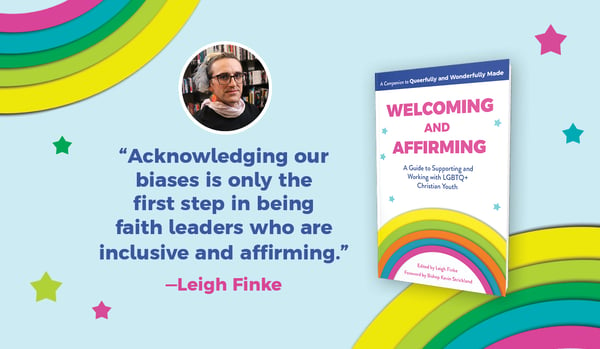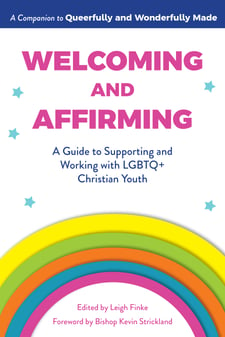
Excerpt from Welcoming & Affirming
Let’s start with the facts: You have biases. We all have biases. We’re born and raised in specific environments, families, and cultures that affect our viewpoints and shape our brains. There’s nothing wrong with having biases, and no shame in acknowledging our biases. They are just there. But acknowledging they exist is the only way to work toward overcoming them.
In order to see your biases, start by simply identifying who you are. For example, you might be a white, middle-class, able-bodied, cisgender, suburban, married man. If so, you have a set of experiences that are different from an African American lesbian, a Latinx nonbinary immigrant, or a disabled white man experiencing homelessness. That you view the world differently makes sense and is not surprising or a failure.
Acknowledging our biases is only the first step in being faith leaders who are inclusive and affirming. We must also consider how our individual life experiences have affected our thinking and assumptions.
Ask yourself:
- What advantages have I had because of my identity? What disadvantages?
- What obstacles have I faced and/or avoided simply because I was born into a certain family, neighborhood, or body?
- What might someone of a different race, gender, or orientation experience that I haven’t?
Obviously, none of us has control over the identities and culture we were born into. But we absolutely do have control over how we leverage those identities and cultures and how we engage with people who are different from us. This is especially true for people of faith. We are called to consider others as valuable as ourselves. We are followers of Jesus, who preached about welcoming strangers and caring for those who suffer. As a youth leader, you have the great privilege of creating spaces of welcome and care for the LGBTQ+ kids in your community who are too often treated as outsiders.
As you consider your personal biases, think too about the biases your church might have. What assumptions are made about queer kids that might be keeping them from being fully welcome? How can you break through some of those and build bridges between your church and your LGBTQ+ students?
Recommendations
If you want to recognize and work through your personal biases, then:
- Participate in a bias training program through your denomination or a community organization.
- Undergo a self-assessment to discover your blind spots and implicit biases (for example, the Harvard Implicit Association Test, or the Implicit Bias Test by the American Bar Association)
- Learn about the harm of your biases through LGBTQ+ people in your denomination.
- Do your own work: Seek educational resources to learn about a contrasting perspective, especially those related to your implicit biases. Read testimonies, stories, and biographies of those from completely different backgrounds than yours.
- Don’t look to your youth for answers. It’s not their responsibility to educate their elders.
If you want to challenge biases among your staff/group, then:
- Create a learning campaign. Encourage your pastoral team, youth volunteers, and staff to take an implicit bias test.
- Host Q&As, read books as a group, watch TED Talks, etc.
- Take your small group through a season of learning about different perspectives on sexuality and gender.
A Final Thought
Recognizing and working through your biases can be hard, lonely work. You will likely feel vulnerable, unnerved, or totally out of your comfort zone as you do so. You might upset friends, family, or colleagues by sharing what you learn. You might be shocked by the changes you see in your heart and viewpoints. Nevertheless, exploring and overcoming your biases is a beautiful journey toward growth and maturity as a leader. And this work is a gift to your vulnerable queer kids.
A Final Final Thought: When You Mess Up
Even with all the research and learning, you’re still going to have unconscious biases. You’re going to make mistakes, whether saying the wrong thing, making the incorrect assumption, or simply forgetting what you’ve learned. This is just part of being human. In fact, we have a whole chapter about just that (see “What If I Get It Wrong?” on page 94).
Eli, 28:
“Negative thoughts toward the LGBTQ+ community are so common that it’s almost impossible to get to adulthood and not have any bias against queer people. So, don’t feel bad or defensive if you find yourself making assumptions about how queer people look, act, or live. Just recognize that you have those pre-existing biases and then work to eliminate them. Honestly, most LGBTQ+ people I know, including myself, have dealt with internalized homophobia/transphobia. I spent years occasionally thinking, ‘I can’t possibly be a lesbian, I like my long hair’ or ‘I don’t want to be a lesbian, lesbians are so mean and scary.’ That’s what society, church, and my family taught me. They probably learned it from someone before them.
“The LGBTQ+ community is as varied as any other community—some people are kind, others not so kind, some people are vocal and proud of who they are, some are more reserved, some are even ashamed. Some are drag queens and activists, some are accountants and airline pilots, some are teachers, some are outlandish, some are as regular as anyone else you meet. Some ‘don’t look gay.’ We come from every type of background, family, and circumstance. So, if you think about the LGBTQ+ community as one big unit, you probably just need to meet more LGBTQ+ people. I think seeking out queer people and getting to know about their lives is the best way to break any biases you have.”
For more information on Welcoming & Affirming, click here.


